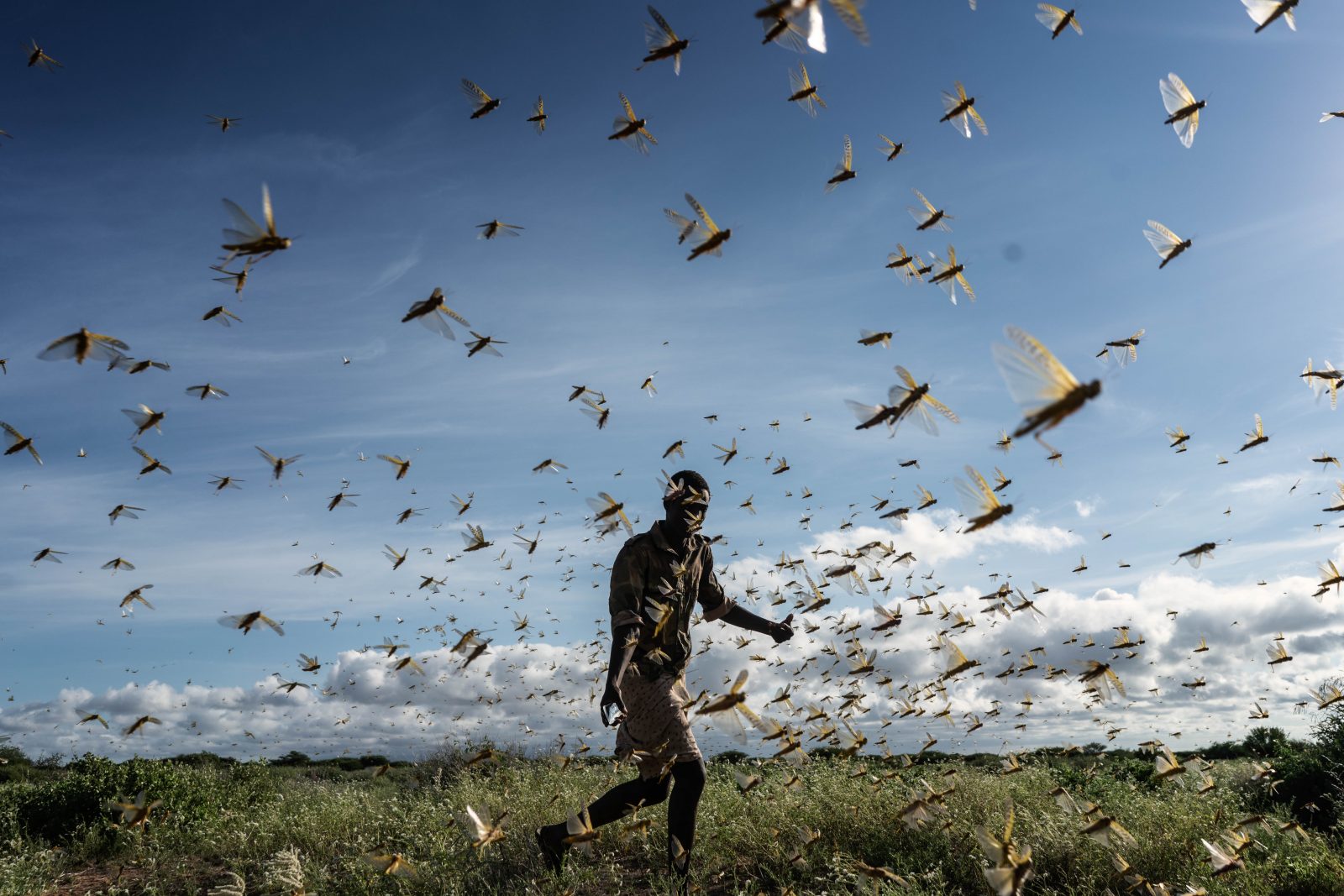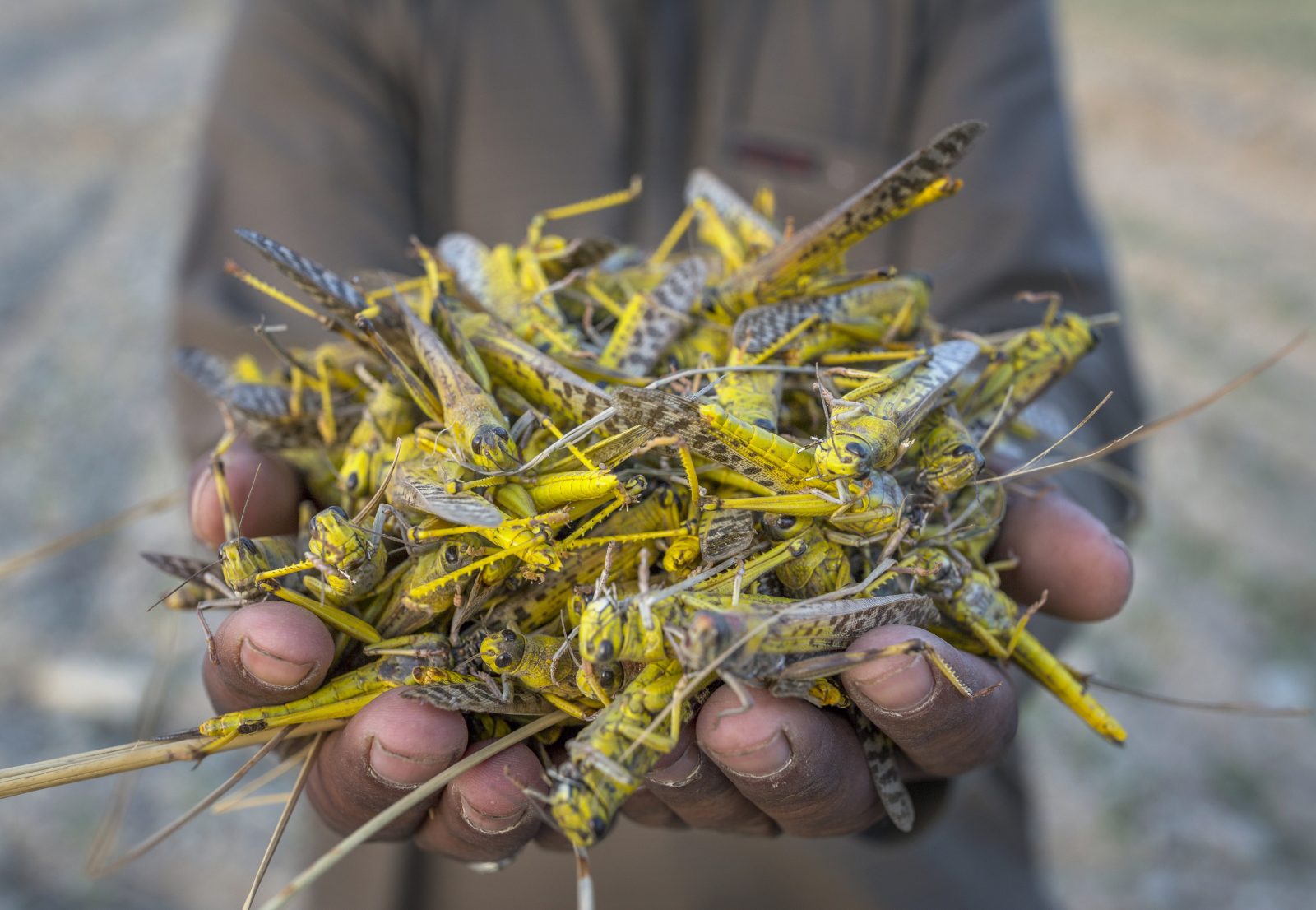They did it under cover of darkness: mothers, fathers, grandparents, children. Only at night are the locusts still and silent, their thick, yellow bodies roosting on whatever trees, crops, and grasses they haven’t already devoured. That’s when families of Kenyan farmers would spring into action, filling sack after burlap sack with swarms of the sleeping bugs.
Since January 2020, against the backdrop of the global pandemic, locusts have been quietly consuming staple crops like wheat and sorghum in East Africa, Yemen, Iran, and Iraq, layering plague upon plague and signalling the future in which climate change makes these swarms more common.
But instead of throwing up their hands, a team of Kenyan entrepreneurs got busy: following the swarms, mobilizing and paying nearby farmers to harvest them, and then grinding them into a protein powder to be sold as feed for livestock. The team of eight, who work for the Kenya-based regenerative agriculture company The Bug Picture, employed 180 harvesters who collected a total of 4.3 tons of locusts over the course of a two-month pilot. The initiative has both offered local farmers a crucial source of income after their crops were destroyed and has pioneered a replacement for less ecologically sustainable animal feeds like soy and fishmeal.
The effort is part of a broader push to capitalize on the potential of insect protein as industrial-scale indoor insect farms crop up around the globe. According to Barclays, the global insect protein market could be worth $8 billion by 2030 (up from $112 million in 2019). Here in the U.S., the industry is just beginning to buzz. In 2018, Ohio-based EnviroFlight opened the country’s first large-scale insect-rearing facility in Kentucky. Two years later, France’s Innovafeed raised $168 million to build another in Illinois. Meanwhile, 50 miles east of Los Angeles, U.K.-based AgriProtein just completed construction of its first stateside facility.
The burgeoning insect industry offers good news at the intersection of several gloomy data points. As land and water grow scarcer, insects like black soldier flies can be bred densely and are not particularly thirsty, requiring less acreage and half as much water as poultry farms. They also convert what they eat into edible protein at a much higher rate than other animals like cows and chickens. On the whole, insects’ carbon footprint is downright dainty; one study found that farming mealworms for human consumption produced 13 times less CO₂ than farming beef. If insect farming can reduce demand for traditional, less sustainable livestock feeds and catch on among us humans, it will curb food insecurity, deforestation, land-grabbing, and overfishing all at once.
The Bug Picture’s founder, Laura Stanford, was excited about insect protein even before the locusts arrived. The former management consultant launched the company in 2018 to rear black soldier fly larvae for animal feed and fertilizer. Based in Nyahuru, Kenya, which the swarms passed through, she already understood the insect market and its untapped potential.
Locusts are typically chill and solitary, but when enough are in proximity, they enter what scientists call a “gregarious state” and begin swarming by the trillions. Locusts have been common in East Africa for all of recorded history, but warming seas have increased rains in the Arabian peninsula, where this year’s swarms originated. More rain means wetter soil and thus more egg-laying.
“It was Biblical plague stuff,” says Stanford. “Black skies.” The United Nations’ Food and Agriculture Organization leapt into action when the swarms began, sending planes to spray the locusts with insecticide. This method does not eliminate the swarms, however; it only contains them, and it also makes the insects poisonous. Stanford’s team worked closely with the FAO field team to avoid harvesting the swarms they’d already sprayed.

Kenya’s last swarm occurred 70 years ago. Since then, more land has been turned into crops rather than left as wild grassland, which makes the locusts, as they look for food, more likely to spoil human livelihoods. Intertwined with the trifecta of worsening drought, population growth, and food insecurity in the region, they’ve been cause for real alarm: Of the 25.3 million food-insecure East Africans, more than 11 million live in areas affected by the locusts, and 7 out of 10 impacted households reported “high” or “very high” losses to their crops or rangeland. While the net impacts of this season’s locusts are still being assessed, swarms that hit West and North Africa in 2003 caused $2.5 billion in total crop damage.
“If it wasn’t for COVID, this infestation would have been the greatest humanitarian crisis” of the last year, says Stanford.
To harvest the locusts, which roost in a new place every night, The Bug Picture team had to assemble local residents on a moment’s notice. “The biggest challenge was that you can’t really do anything until the swarm roosts, which doesn’t happen until around 6 p.m.,” Scilla Allen, the project manager, explains. She found it important to assemble her crews before nightfall. “That leaves less than an hour to mobilize the nearest community, explain what you’re asking them to do, convince them to trust you, show them how to do it, and get the whole ball rolling,” she says. Most groups would harvest for about two hours per night, shaking the bugs off trees or scooping them off the ground by the armload.
Sometimes the swarms would roost on private property, with landowners less than thrilled at the prospect of a squad of civilian locust-collectors storming their fields at dusk. One time, the team followed the swarms into the company of elephants. “The elephants decided pretty quickly they didn’t want us there,” Allen says, laughing. When a swarm circled back to one area for a second time, however, and the locals knew what to expect, they harvested a whole ton in one night.
While the desert locust can be found near the equator across Africa, the Middle East, and Asia, threatening one-fifth of the earth’s land, harvesting by hand is not the most efficient or scalable way to collect the critters. Dr. Chrysanthus Tanga, an entomologist at the International Center of Insect Physiology and Ecology, is developing affordable suction devices to make it easier. “They look like leaf-blowers but work as vacuums, and could enable farmers to harvest locusts at much higher rates,” he says. Tanga also worked with the Kenyan government in December to develop new legal standards for consumption and enable commercialization. If the market can scale up, he says, there will be more incentive to harvest.
There may also be a nutritional incentive. “Already, chickens will by themselves excavate for insects,” says Dr. Matthew Gicheha, an entomologist at the Jomo Kenyatta University of Agriculture and Technology who has been working with The Bug Picture to conduct research on the health impacts of replacing conventional feeds with locust protein. His findings are promising. “So far, the chickens fed with 50 percent and 75 percent locust protein are superior to the control” in terms of weight gain, he says. His results are consistent with trials done on feeds made from black soldier fly larvae.
An expanded insect market stands to improve not only how we feed livestock, but also how we deal with food waste — reflecting the ideals of the circular economy and cutting carbon emissions in the process. While locusts cause trouble by eating crops meant for humans, farmed insects can be fed waste that might otherwise be useless: rotten fruits, agricultural byproducts, even human poop. One U.S.-based company, Chonex, feeds poultry manure to its flies and then feeds the larva back to the chickens.
Even though the FDA still categorizes insects as “filth” rather than “food,” the U.S. regulatory landscape is fairly welcoming — more than, say, the E.U.’s, which only permits insect feed in aquaculture. In 2018, the FDA authorized the use of dried insects and larvae in both poultry and fish feeds. Selling crickets for human consumption is also legal, so long as they are farmed and not harvested in the wild.
Global meat demand — and the rising emissions that come with it — is projected to grow more than 75 percent by 2050 as populations and incomes rise. But by replacing conventional livestock feed with the more sustainable insect protein, much of agriculture’s ecological footprint could be mitigated.
Dr. William Clark, a biologist and policy analyst at Zero Waste Scotland who is focused on the insect industry, stresses the environmental and social benefits of such a replacement. Fishmeal, for one, is becoming increasingly expensive and unavailable because of overfishing. Soy is not much better; as demand rises but arable land becomes scarcer, soy farming has been linked to land-grabbing from Indigenous people and deforestation in Brazil, where most soy is produced. “Then there’s the carbon benefit of not shipping soy and fishmeal around the world,” Clark adds.
Gicheha points out that when locusts aren’t devouring crops, they often feed on inaccessible grasslands, so if they’re harvested they loop nutrients into the human food chain that would otherwise be out of reach.
“I don’t want to call this an ‘invasion,’” he says, “because it might provide opportunity, depending on how we look at it.”



